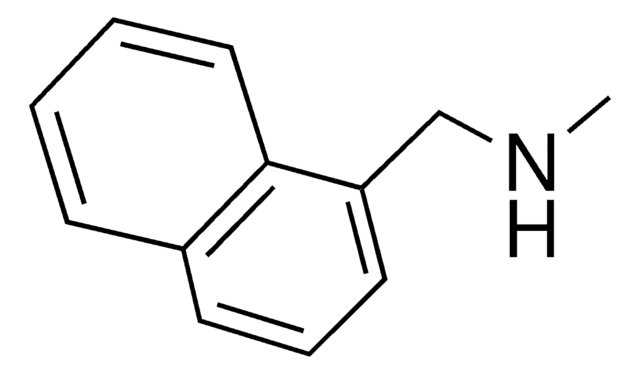127035
1-Naphthylmethylamine
97%
Synonyme(s) :
1-(Aminomethyl)naphthalene, 1-Naphthalenemethylamine
About This Item
Produits recommandés
Pureté
97%
Forme
liquid
Indice de réfraction
n20/D 1.643 (lit.)
Point d'ébullition
290-293 °C (lit.)
Densité
1.073 g/mL at 25 °C (lit.)
Chaîne SMILES
NCc1cccc2ccccc12
InChI
1S/C11H11N/c12-8-10-6-3-5-9-4-1-2-7-11(9)10/h1-7H,8,12H2
Clé InChI
NVSYANRBXPURRQ-UHFFFAOYSA-N
Informations sur le gène
rat ... Adra2a(25083)
Vous recherchez des produits similaires ? Visite Guide de comparaison des produits
Catégories apparentées
Description générale
1-Naphthylmethylamine increases the induced circular dichroism (ICD) magnitude exhibited by Poly[(4-carboxyphenyl)acetylene]. It forms carbamate by reacting with monomethoxypoly(ethylene glycol) succinimido carbonate (mPEG-SC).
Application
- Photoluminescence Modulation: A study demonstrates the modulation of photoluminescence in Ruddlesden-Popper perovskite using phase distribution regulation, revealing potential applications in optoelectronic devices. 1-Naphthylmethylamine plays a critical role in enhancing the material properties for improved device performance (Zhao et al., 2023).
- Perovskite Light-Emitting Diodes: Research highlights the dimensional tailoring of quantum wells through ultrahigh vacuum annealing to enhance the efficiency of perovskite light-emitting diodes. This process utilizes 1-Naphthylmethylamine to improve the interlayer electronic properties and device stability, contributing significantly to advancements in LED technology (Yu et al., 2020).
Mention d'avertissement
Warning
Mentions de danger
Conseils de prudence
Classification des risques
Eye Irrit. 2 - Skin Irrit. 2 - STOT SE 3
Organes cibles
Respiratory system
Code de la classe de stockage
10 - Combustible liquids
Classe de danger pour l'eau (WGK)
WGK 3
Point d'éclair (°F)
235.4 °F - closed cup
Point d'éclair (°C)
113 °C - closed cup
Équipement de protection individuelle
Eyeshields, Gloves, type ABEK (EN14387) respirator filter
Certificats d'analyse (COA)
Recherchez un Certificats d'analyse (COA) en saisissant le numéro de lot du produit. Les numéros de lot figurent sur l'étiquette du produit après les mots "Lot" ou "Batch".
Déjà en possession de ce produit ?
Retrouvez la documentation relative aux produits que vous avez récemment achetés dans la Bibliothèque de documents.
Les clients ont également consulté
Notre équipe de scientifiques dispose d'une expérience dans tous les secteurs de la recherche, notamment en sciences de la vie, science des matériaux, synthèse chimique, chromatographie, analyse et dans de nombreux autres domaines..
Contacter notre Service technique










